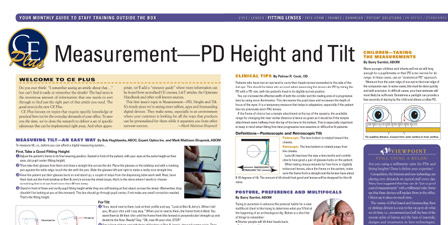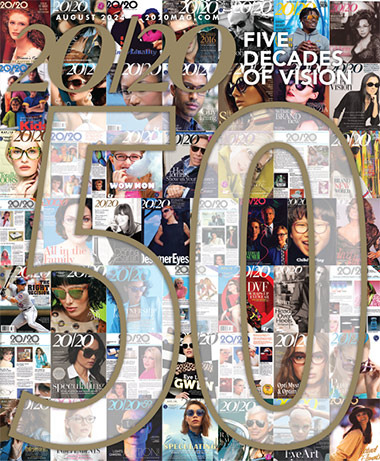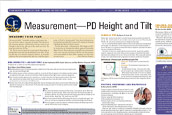
By Linda Conlin
No optometrist or ophthalmologist. Just one optician and hundreds of people with no place to turn and vision impairments as minor as presbyopia and as dire as cataracts and glaucoma. That’s the situation in which retired optician Bruce Tooker found himself on his first day with MATH (Medical Aid to Haiti), a group on a mission to bring medical care to Haitians in need.
Devastated by a massive earthquake, powerful hurricanes, political unrest and decades of instability, many Haitians don’t have a privilege so many of us take for granted: access to basic health and vision care. One group is slowly changing that story.
MATH grew out of a medical ministry in West Hartford, Conn., to become a charitable organization with the sustainable mission of “Helping Haitians Heal Haitians.” In collaboration with Haitian doctors, they help support the medical needs of approximately 17,000 patients a year. In Port-au-Prince, MATH sponsors Centre Medico-Chirurgical du Quartier (Neighborhood Medical-Surgical Clinic) in Delmas 60, led by a Haitian physician/surgeon and staffed by Haitian nurses and health care personnel. Karavan LaSante, the mobile clinic extension of the clinic, provides continuing primary care to villagers in five medically underserved areas around Port-au-Prince—Croix-des-Bouquets, Grand Boulage, Lilavois, Marlique and Santo. In Dame-Marie, a fishing village in the south-westernmost part of Haiti, MATH supports an ob-gyn and anesthesiologist, who provides obstetrical services at Hopital de la Communaute Dame-Marienne (Community Hospital of Dame-Marie).
Since 2016, Tooker has taken on the task of serving the vision care needs for those patients.
Tooker’s direct involvement with MATH came about in an unusual way. He had supported MATH through donating ready readers, but one day, a medical issue brought him to the ER. Chatting with the nurse, she confessed that she was tired, having just returned from Haiti with MATH. Tooker recognized the organization and they talked about her experience. By the end of the nurse’s shift, Tooker agreed to join a mission as an optician.
In November 2016, Tooker made his first trip to Haiti, covering out-of-pocket the $1,500 each volunteer pays for travel and lodging. With some donations and at his own expense, he collected a portable phoropter, some flip lenses, Snellen chart and ready readers in powers from +1.00 to +4.50, because a colleague informed him of the low incidence of myopia and astigmatism, but high rates of hyperopia and presbyopia. “Everything is new,” he says. “We don’t bring any used materials.” Beyond that, Tooker didn’t know what to expect.
The group of nurses, a doctor and health care volunteers arrived at a metal-gated mission house surrounded by razor wire in Port-au-Prince. A guard armed with a gun and a fierce-looking dog greeted them. Their hosts advised them to eat and drink water only at the mission house. Tooker wondered what he had gotten himself into. The next day, they drove to the mobile clinic site inside a mission school in Grand Boulage in the mountains where about 100 people were already waiting for them. Everyone was dressed in their one best outfit, usually reserved for church and special occasions.
Inside they had no power or lights, so they worked near the windows. The portable autorefractor was useless. The Snellen chart was nearly as useless. Most of the patients were illiterate, although the men could read numbers. As the majority didn’t have regular jobs, determining visual needs was difficult. To avoid embarrassing the patients, with the help of an interpreter, Tooker asked what they liked to do. Men worked with their hands and wanted more intermediate vision than close. The women wanted to thread a needle, so the volunteers procured needles and thread for subsequent trips. To determine distance vision needs, Tooker brought his patients to the window to look at the trees.
As the only eyecare professional, Tooker triaged every patient. He sent apparent medical issues to the team physician, but Tooker was responsible for identifying vision problems and determining the best prescriptions for glasses, primarily relying on the general guidelines he knew for add power by age. If he didn’t have glasses that matched the power the patient needed, Tooker had the glasses made in the U.S. and sent them back to the clinic, as he did for the rare -6.00 myope. For the 10-year-old boy who had trouble reading by candlelight, Tooker hoped that a pair of +.50 glasses would help.
The team had similar encounters in the other villages. At a church in Santo, people began to wait at 6 a.m. The volunteers arrived at 9 a.m. after a two-hour van ride to make the 20-mile trip on rugged, unpaved roads. The waiting patients prayed and sang the hymn “How Great Thou Art” in Creole as the team set up the clinic. The volunteers were moved to tears. “They are a gentle, kind people,” Tooker says. In Lilavois, the clinic operated inside a cinderblock building with only a bucket as a lavatory. In spite of the conditions and a trip cut short by political unrest, Tooker evaluated a total of 240 people for vision problems.
Many didn’t realize how poor their vision was. Upon receiving glasses, they danced and sang. Tooker said the experience was “humbling” when he realized it was likely the first time in a long time the people could see well. Cataracts were common, affecting some as young as age 30, perhaps due to lack of sun protection and poor diet. With neither the money nor the opportunity for cataract surgery, those patients would do the best they could with glasses. Dry, itchy and watery eyes also were a common problem. Everyone except the man who wore a baseball cap that protected him from the sun had a pterygium. The typical solution, eyedrops, was impractical because once the drops ran out, the people could get no more. The best solution: Give them sunglasses for protection and facecloths for cool compresses.
For his next trip this past September 2017, Tooker developed a basic vision testing handbook (see sidebar below)
to leave with the Haitian clinic staff. In a week, he trained some staff in the basics of interpreting patient complaints and estimating the power of the glasses needed. He saw nearly 250 patients or as Tooker says, “We made 250 people happy.”
Tooker doesn’t get feedback from his patients, but he knows much more needs to be done. The biggest challenge, he says, is growing the program in Port-au-Prince, as well as expanding the program to Dame-Marie. Tooker and the MATH team met with a Haitian ophthalmologist and developed a project proposal that could begin to treat the clinic population who have little or no access to eyecare, but have glaucoma that is estimated at 20 percent of the population, as well as the majority of adults who have cataracts.
But things move slowly in Haiti, and he has little confidence there will be enough funding for ophthalmological equipment and services. “There are no resources,” Tooker says. Tooker is currently looking for sources to fund this project. “It takes only $120 or $10 a month for cataract surgery to restore sight to one eye in one person.” MATH also needs volunteers, and that’s why Tooker wants to pass along the things he has learned on the missions. The smiles, songs, dances and tears he saw in Haiti were “a larger paycheck than I ever earned” in more than four decades as an optician.
For more information about MATH, visit medicalaidtohaiti.org.
By Bruce Tooker
Many older folks cannot see to thread a needle (have a sewing needle and thread when testing). Usually requires a stronger power and held at 12 inches. Many of the older patients are illiterate. So as to not embarrass them, use the numbered side of the reading card to test. (In general, ladies—sewing needle, men—numbered card.)
For many of the older men, close work at 18 to 20 inches may be a more comfortable distance. If near card is clear at 16 inches, and you want to be clear at 20 inches, drop down to the next power.
Patients with cataracts (cloudy eyes) who are having trouble seeing distance are sometimes helped by low power plus lenses, +.50 or +100, or low power minus lenses. Try different powers with patients looking outside at trees, etc.
A small percentage of patients at each of the clinics were myopic (distance glasses). Use flip lenses to test. Most were -.50, some were stronger. Use portable refractor and phoropter to determine power. Use a millimeter ruler to measure pupillary distance (PD) between patient’s eyes, and e-mail PD measurement and power, name and age of patient, contact info, plus name of clinic, and we will order glasses.
- Patient complaint of itchy and watery eyes
Solution: Use a cold water compress on the eyes each morning and evening to cleanse the eyes from dust and smoke. We instilled saline drops and had the patients close their eyes for a minute before vision testing. - Patient complaint of "flesh on the eyes" (Pterygium a benign growth on the conjunctiva caused by UV light and dust)
Solution: Dispense good sunglasses to slow and prevent growth. - Patient complaint of "veil over the eyes" (cataracts, clouding of the natural lens located behind the pupil). Most patients had some cataract development, caused by aging and UV exposure.
Solution: Refraction and glasses to improve acuity.
- Teenage to 30 years old = +.50, +1.00, +1.50 Many times young students will fatigue when reading in poor light conditions; +.50 will help.
- 40 to 50 years old = +1.50 to +2.50
- 50 to 60 years old = +2.00 to +3.00
- 60 years-plus = +2.00 to +4.00
Many older folks cannot see to thread a needle (have a sewing needle and thread when testing). Usually requires a stronger power and held at 12 inches. Many of the older patients are illiterate. So as to not embarrass them, use the numbered side of the reading card to test. (In general, ladies—sewing needle, men—numbered card.)
For many of the older men, close work at 18 to 20 inches may be a more comfortable distance. If near card is clear at 16 inches, and you want to be clear at 20 inches, drop down to the next power.
Patients with cataracts (cloudy eyes) who are having trouble seeing distance are sometimes helped by low power plus lenses, +.50 or +100, or low power minus lenses. Try different powers with patients looking outside at trees, etc.
A small percentage of patients at each of the clinics were myopic (distance glasses). Use flip lenses to test. Most were -.50, some were stronger. Use portable refractor and phoropter to determine power. Use a millimeter ruler to measure pupillary distance (PD) between patient’s eyes, and e-mail PD measurement and power, name and age of patient, contact info, plus name of clinic, and we will order glasses.












